2015 in Review and Top 20 + 10 Shakespeareances
Epiphany Keeps '15 From Being a Rotten Year
You couldn't ask for a better start to a new year: accompanied by the sexiest woman on the planet (Sarah, my wife), seeing Elton John in concert as New Year's Eve hit midnight, then having brunch with son Jonathan at an East Village jazz bar. What else could a New Year's celebration want?
Hoppin' John and cornbread, that's what.
Every New Year's Day, Sarah fixes this traditional Southern meal which is supposed to ensure good luck for the coming year. We've had a good life, but I always wondered—only half joking—just how much luck black-eyed peas and ham ever really mustered for us per year. Then, last New Year's we spent in Brooklyn, New York, instead of at home, and we didn't have our traditional Hoppin' John meal, and I got my answer.
We'll never make that mistake again. We're having Hoppin' John today, with collard greens (supposed to bring prosperity). I'm a guy who doesn't buy into all the Macbeth hoo-hah, but the 2015 we've had is enough to convince me that the Hoppin' John tradition has much merit. And with that, we'll kick off a new year of Shakespeareances by, um, still writing reviews of last year's Shakespeareances.
Which is fitting if not fully justifiable. Shakespeareances—both the passion and the website—has had to take a back seat to the dramas of real life in 2015. I've written about these adventures in previous columns (and fully detail them in my commentary for Sarah's birthday, linked in the sidebar on the right), but here's a short recap. By this time last year Sarah was undergoing several tests and procedures to explain mystery fainting spells; one year later she has a pacemaker to keep her heart from stopping and from speeding up (both were happening) and she has no thyroid, thanks to cancer. In January, my father began having medical issues that were long-term manifestations of his stroke five years ago; after four months, one procedure, and overcoming some complications afterward, he resumed his normal life in early summer until pneumonia knocked him down this past autumn. He still hasn't fully recovered. Between Sarah (not allowed to drive until six months after her last fainting spell) and my dad (who lives eight hours away), I spent more time behind the wheel of our car than at my desk or in a theater. Until the summer, that is, when I took a temporary editing and project management gig that has been requiring 60-hour workweeks.
Consequently, the number of Shakespeare plays we've seen declined in 2015 to 33 from the 60 we saw in 2014 (we also saw the second season of the Public Broadcasting System's Shakespeare Uncovered in 2015). The number of non-Shakespeare plays we've seen jumped from 23 in 2014 to 31 this past year, but that includes four Shakespeare-related plays: West Side Story based on Romeo and Juliet, Kiss Me Kate based on The Taming of the Shrew, the Bard on the Beach production Shakespeare's Rebel that's kind of about Shakespeare, and the new Broadway play Something Rotten that's kind of about Shakespeare.
On stage, the obvious Shakespeare trend this year is not only how Henry IV became one of the most produced of Shakespeare's compositions, but how often women featured prominently in the performance of the play. We saw three productions of Henry IV, Part One (Baltimore Shakespeare Factory being one of those), twice in tandem with Henry IV, Part Two (Smith Street Players in New York and Brave Spirits in Alexandria, Virginia). We saw the two plays combined into one production (Donmar Warehouse's production at St. Ann's Warehouse in Brooklyn, New York), and we saw the two plays combined with Richard II and Henry V in the four-part presentation DruidShakespeare: The History Plays in the Lincoln Center Festival in New York. The cast was all-female in both the Baltimore Shakespeare Factory and Donmar Warehouse productions, while Brave Spirits re-gendered the play (male roles played by women, the few women played by men, except Lady Hotspur). Both Smith Street and DruidShakespeare cast women as Henry and Hal, with DruidShakespeare blurring gender lines in the characterizations (if you are counting, that's five female King Henrys and five female Prince Hals in one year).
Cross-gendered casting was something of a theme this year beyond the Henry plays. In addition to Taffety Punk's annual Riot Grrrls production (The Tempest this year), we took in Titan Theatre Company's Amazonian Othello. Bedlam used a cast of five to do two different versions of Twelfth Night in repertoire, both featuring notable cross-gendered casting. Even the annual production of A Christmas Carol at the American Shakespeare Center cast an actress as Scrooge, and she was one of the truest-to-Dickens' Scrooges I've ever seen.
We saw one woman play 13 roles in a somewhat autobiographical play (Ginna Hoben's The Twelve Dates of Christmas), and we saw four women play a single character in a mostly biographical play (Compagnia de' Colombari's production of texts&beheadings/ElizabethR at the Folger Theatre). We took in several such thought-provoking, envelope-pushing productions this year, including Shakespeare productions, ranging from the ingenious (Bard on the Beach's steampunk production of A Comedy of Errors) to the horrible (Wooster Theater Company's Cry Trojans that turned Troilus and Cressida into a hallucinogenic stereotype of Native American culture).
Merely speaking the way Shakespeare spoke also grabbed our headlines this year. We saw an original pronunciation production of The Merchant of Venice (Baltimore Shakespeare Factory), in the spring, the actors learning to deliver their lines as scholars believe the Elizabethans would have heard them. Then, in the fall, the Oregon Shakespeare Festival created a firestorm of protest among Shakegeeks around the globe when it announced a project to "translate" all of Shakespeare's works into contemporary English. Finally, Synetic's brilliant "Silent Shakespeare" series came under fire from conservative politicians who labeled an arts grant to the company a waste of federal money because, well, why would you want to see Shakespeare without words? (Not a new concept, if you are familiar with Mendelssohn or Prokofiev, among many others). So, even in my Shakespeare realm, what happened offstage seemed to overwhelm what was happening onstage this past year.
And yet…
Shakespeare himself came to possess my very being this past year—actually, it wasn't really the Bard but the actor playing him. We also had a transformative theater experience in 2015. I've seen more than my fair share of transcendent productions and performances, but transformative theater is something rarer. Two such productions were Les Miserables in the way it affected my heart and soul with its powerfully rendered message of love and faith, and The Lion King in the way it affected my heart and mind with its multimodal theatrical format. A third production joined that elite set this year, in part for the way it exploded theater conventions by using the most traditional of theater conventions in one of the most traditional of plays, but also because of how poignantly it presented that play's thematic message. It would have been powerful any time, but it was especially so coming in our 2015, for it raised all the turmoil and toil we were enduring into a spiritual experience.
It's the only production that overcame what otherwise would have been a Rotten year (geesh, I'm bloody brilliant). However, it complicates this annual countdown format because normally I start with the Top 20 Shakespeare productions, then list my favorite non-Shakespeare productions as "Honorable Mentions." This year's best of shows, though not a Shakespeare-written play, is beyond "honorable mention," so I'm leading off with it before moving on to the Top 20 Shakespeare productions.
Eric Minton
January 1, 2016
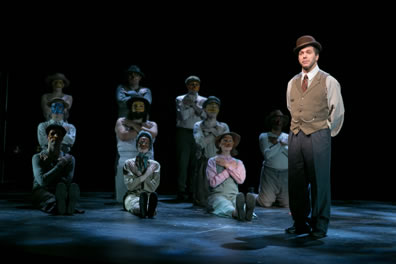
The Stage Manager (Matthew Pauli) guides us through the Grover's Corners cemetary, played by the masked ensemble, in the Faction of Fools commedia dell'arte production of Thornton Wilder's Our Town at Gallaudet University's Elstad Audtiorium. Photo by C. Stanley Photography, Faction of Fools Theatre Company.
Best Show of Shows
Our Town, Faction of Fools, Washington, D.C. Combine Faction of Fools' expertise with commedia dell'arte and its irreverent ingenuity with Thornton Wilder's slice-of-Americana masterpiece, and you know you are headed for hilarity. But something is missing from the formula: irreverence. This production is so faithful to Wilder's play that the commedia elements restore Our Town to the deeply profound drama it is supposed to be. Director Matthew R. Wilson is brilliant in the way he fuses commedia conventions into the metatheater conditions of Wilder's script, but his genius is in turning those commedia conventions inside out to bring home the play's powerful message on life, death, and living, depositing that theme into the very soul of those watching the play. On a personal level, while I've seen great theater over the years, only one other time did a show reach the level of epiphany for me, and that was Les Miserables. This production, like Les Miserables but also The Lion King, and Othello: The Remix, is one of those leaps into theatrical singularity in which a vision combined with great talent and clear-eyed ingenuity creates a once-in-an-epoch event.
Top 20 Shakespeareances of 2015
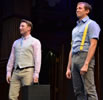 The Two Gentlemen of Verona, Taffety Punk, Washington, D.C. We laugh and laugh a lot. We tell Proteus, "noooooo!" We admire the individual characters and the tight ensemble work. We reflect on the human foibles those characters show us. We love the play. That's all good Shakespearean theater, but what's remarkable here—miraculous, even—is that this Bootleg Shakespeare production is mounted in only one day and performed just one time. Not only that, it's friggin' Two Gentlemen of Verona we're lauding. Under the clear and concerted vision of Director Marcus Kyd and the Shakespearean talents of an all-star D.C. cast, Two Gents proves to be a perfectly fine play, funny and dramatic in turns with no more plot holes than we see in any other Shakespeare works. Even the problematic ending makes sense when Dan Crane plays Valentine as a dimwit, Shawn Egan plays Proteus as incessantly charming, Tonya Beckman plays Sylvia as a post-Bachelorette diva, and Kimberly Gilbert gives her art nerd Julia a hilarious ironic rage. Add in a dry-wit portrayal of Speed from Esther Williamson and an embarrassingly funny playboy Italian Thurio from Ashley Strand, and we get a one-night stand beyond your dreams. If it could ever get an extended run—say, one week instead of one night—it would raise Shakespeare's notoriously flawed play to a stature among his best works.
The Two Gentlemen of Verona, Taffety Punk, Washington, D.C. We laugh and laugh a lot. We tell Proteus, "noooooo!" We admire the individual characters and the tight ensemble work. We reflect on the human foibles those characters show us. We love the play. That's all good Shakespearean theater, but what's remarkable here—miraculous, even—is that this Bootleg Shakespeare production is mounted in only one day and performed just one time. Not only that, it's friggin' Two Gentlemen of Verona we're lauding. Under the clear and concerted vision of Director Marcus Kyd and the Shakespearean talents of an all-star D.C. cast, Two Gents proves to be a perfectly fine play, funny and dramatic in turns with no more plot holes than we see in any other Shakespeare works. Even the problematic ending makes sense when Dan Crane plays Valentine as a dimwit, Shawn Egan plays Proteus as incessantly charming, Tonya Beckman plays Sylvia as a post-Bachelorette diva, and Kimberly Gilbert gives her art nerd Julia a hilarious ironic rage. Add in a dry-wit portrayal of Speed from Esther Williamson and an embarrassingly funny playboy Italian Thurio from Ashley Strand, and we get a one-night stand beyond your dreams. If it could ever get an extended run—say, one week instead of one night—it would raise Shakespeare's notoriously flawed play to a stature among his best works.
 Twelfth Night and What You Will, Bedlam, Dorothy Strelsin Theatre, New York, N.Y. Had this twin bill featuring two approaches to Twelfth Night gone the way I expected—with a lighthearted and a darkhearted version of the play—it likely would have at least made the top ten of this list. But Director Eric Tucker eschews darkness and instead goes for a straightforward and not-straight pairing of plays, both hilarious, and both exquisitely acted. The talent level of this troupe is incredibly high. Edmund Lewis glides through his reading of Malvolio as a bully in one play and an effete dreamer in the other. Tom O'Keefe presents a multivoiced Feste and Fabian. Andrus Nichols plays Orsino and Maria in one play, and Olivia and a most vile Toby in the other. Tucker plays the twins and Toby in one play and a gay Aguecheek and partying Orsino in the other. But what lodges this pair of productions near the top of this list is Susannah Millonzi: her Texas slacker Aguecheek in one play and dormouse lion of a Maria in the other are comic gems, but her simple, text-centric Olivia is the revelation, presenting a woman so giddy in love that her heart carries away her personality. Either of these versions of Twelfth Night would easily make the top five; paired, Bedlam's renditions of this play are nonpareil.
Twelfth Night and What You Will, Bedlam, Dorothy Strelsin Theatre, New York, N.Y. Had this twin bill featuring two approaches to Twelfth Night gone the way I expected—with a lighthearted and a darkhearted version of the play—it likely would have at least made the top ten of this list. But Director Eric Tucker eschews darkness and instead goes for a straightforward and not-straight pairing of plays, both hilarious, and both exquisitely acted. The talent level of this troupe is incredibly high. Edmund Lewis glides through his reading of Malvolio as a bully in one play and an effete dreamer in the other. Tom O'Keefe presents a multivoiced Feste and Fabian. Andrus Nichols plays Orsino and Maria in one play, and Olivia and a most vile Toby in the other. Tucker plays the twins and Toby in one play and a gay Aguecheek and partying Orsino in the other. But what lodges this pair of productions near the top of this list is Susannah Millonzi: her Texas slacker Aguecheek in one play and dormouse lion of a Maria in the other are comic gems, but her simple, text-centric Olivia is the revelation, presenting a woman so giddy in love that her heart carries away her personality. Either of these versions of Twelfth Night would easily make the top five; paired, Bedlam's renditions of this play are nonpareil.
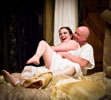 Sarah Fallon as Cleopatra, Antony and Cleopatra, American Shakespeare Center, Blackfriars Playhouse, Staunton, Va. If there is such a thing as a definitive Cleopatra, it is in Enobarbus' descriptions of her. Sarah Fallon is the first of even the great Cleopatras I've seen (Judi Dench, Glenda Jackson, Yanna McIntosh) who matches the vision Enobarbus replicates with his words (and in the acting of Rick Blunt, Enobarbus's face fills with an expression of having waken from a gorgeous dream). Fallon knows how to play power, she knows how to play passion, she knows how to play petulance, and, most of all, she knows how to play regality. She also knows as well as anyone in theater how to speak Shakespeare's verse, so her Cleopatra is exactly what Shakespeare portrays, a woman with a spectrum of moods and a heart overflowing with poetic love. Fallon's performance might not be definitive, but it's definitely Shakespeare's (and Enobarbus's) Cleopatra.
Sarah Fallon as Cleopatra, Antony and Cleopatra, American Shakespeare Center, Blackfriars Playhouse, Staunton, Va. If there is such a thing as a definitive Cleopatra, it is in Enobarbus' descriptions of her. Sarah Fallon is the first of even the great Cleopatras I've seen (Judi Dench, Glenda Jackson, Yanna McIntosh) who matches the vision Enobarbus replicates with his words (and in the acting of Rick Blunt, Enobarbus's face fills with an expression of having waken from a gorgeous dream). Fallon knows how to play power, she knows how to play passion, she knows how to play petulance, and, most of all, she knows how to play regality. She also knows as well as anyone in theater how to speak Shakespeare's verse, so her Cleopatra is exactly what Shakespeare portrays, a woman with a spectrum of moods and a heart overflowing with poetic love. Fallon's performance might not be definitive, but it's definitely Shakespeare's (and Enobarbus's) Cleopatra.
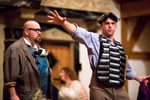 A Midsummer Night's Dream, American Shakespeare Center, Blackfriars Playhouse, Staunton, Va. A company completely comprised of Blackfriars veterans and a director, Ralph Alan Cohen, keeping everybody textually true (except himself in doubling Hippolyta and Snug, leading to the production's one awkward misstep) means this Dream fires on all cylinders: the fairies, the lovers, and the rude mechanicals. Nevertheless, one star emerges above the rest, and it is Gregory Jon Phelps as Bottom—or maybe it is Bottom himself in the role of Pyramus feeding off the Blackfriars' unique atmosphere and audience-actor intimacy. Phelps gives such a singularly comic performance that even his fellow castmates can't keep their composures.
A Midsummer Night's Dream, American Shakespeare Center, Blackfriars Playhouse, Staunton, Va. A company completely comprised of Blackfriars veterans and a director, Ralph Alan Cohen, keeping everybody textually true (except himself in doubling Hippolyta and Snug, leading to the production's one awkward misstep) means this Dream fires on all cylinders: the fairies, the lovers, and the rude mechanicals. Nevertheless, one star emerges above the rest, and it is Gregory Jon Phelps as Bottom—or maybe it is Bottom himself in the role of Pyramus feeding off the Blackfriars' unique atmosphere and audience-actor intimacy. Phelps gives such a singularly comic performance that even his fellow castmates can't keep their composures.
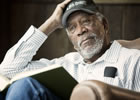 Shakespeare Uncovered, Season Two, PBS. To say this second set of mini-documentaries, in which celebrity hosts walk us through six different Shakespeare plays, far surpasses the first season doesn't come close to measuring how valuable these programs are: from the dramatic rehearsals of scenes by actors at Shakespeares's Globe to the performances of alternate versions; from the break-down of specific speeches to the detailed delving into historical context; from the interviews with actors, directors, and scholars to the visual imagery of the filming itself. Each episode serves as brilliant primers of these plays for newcomers to Shakespeare while enriching lifelong Bardolaters' appreciation of Shakespeare's works.
Shakespeare Uncovered, Season Two, PBS. To say this second set of mini-documentaries, in which celebrity hosts walk us through six different Shakespeare plays, far surpasses the first season doesn't come close to measuring how valuable these programs are: from the dramatic rehearsals of scenes by actors at Shakespeares's Globe to the performances of alternate versions; from the break-down of specific speeches to the detailed delving into historical context; from the interviews with actors, directors, and scholars to the visual imagery of the filming itself. Each episode serves as brilliant primers of these plays for newcomers to Shakespeare while enriching lifelong Bardolaters' appreciation of Shakespeare's works.
 The Comedy of Errors, Bard on the Beach, Vancouver, B.C. There is the squid-like thing trying to escape the pot of boiling water that Dromio of Ephesus batters into submission with a spoon. There is the carnivorous plant cavorting as Antipholus of Syracuse courts Luciana: Nell sates the plant by feeding it her finger—which grows back (this is a zombie-like Nell who only screeches). There is the giant contraption of a wall—all gears and valves and tubes—there are the gas masks, boar visors, and bionic hands. And there is great, great Shakespeare. Director Scott Bellis sets his production in a steampunk setting, which would have been fun on its own. But he generally stays true to Shakespeare's text, and the cast speaks the verse with intelligence and grace—despite their industrial gothic Old West exotica clothing. It is bizarre and it is brilliant.
The Comedy of Errors, Bard on the Beach, Vancouver, B.C. There is the squid-like thing trying to escape the pot of boiling water that Dromio of Ephesus batters into submission with a spoon. There is the carnivorous plant cavorting as Antipholus of Syracuse courts Luciana: Nell sates the plant by feeding it her finger—which grows back (this is a zombie-like Nell who only screeches). There is the giant contraption of a wall—all gears and valves and tubes—there are the gas masks, boar visors, and bionic hands. And there is great, great Shakespeare. Director Scott Bellis sets his production in a steampunk setting, which would have been fun on its own. But he generally stays true to Shakespeare's text, and the cast speaks the verse with intelligence and grace—despite their industrial gothic Old West exotica clothing. It is bizarre and it is brilliant.
 King Lear, Idaho Shakespeare Festival, Boise, Idaho. This production gets an unfair advantage on this list because we saw it twice, one performance being a "family" version with the sexual innuendo tamped down (but the violence in full force). Seeing it a second time allowed us to further study how richly detailed this Joseph Hanreddy–directed, modern-dress production is in the acting and the blocking. These are characters we know in our every-day lives—and whom we both idolize and fear in the case of the Cornwalls. It's a society we understand. And it is unsettling. Though I didn't weep at the end, the overall effect of a production that highlight's the play's elder abuse and illustrates how the haves abuse the lesser haves and ignore the have nots gnaws at my conscience even still. Robyn Cohen's fashion-plate socialite of a Regan is one of the most arresting performances of the year, and I'd just as soon forget Dustin Tucker's Cornwall but I can't—I'm constantly seeing his kind on TV coverage of the U.S. presidential campaign.
King Lear, Idaho Shakespeare Festival, Boise, Idaho. This production gets an unfair advantage on this list because we saw it twice, one performance being a "family" version with the sexual innuendo tamped down (but the violence in full force). Seeing it a second time allowed us to further study how richly detailed this Joseph Hanreddy–directed, modern-dress production is in the acting and the blocking. These are characters we know in our every-day lives—and whom we both idolize and fear in the case of the Cornwalls. It's a society we understand. And it is unsettling. Though I didn't weep at the end, the overall effect of a production that highlight's the play's elder abuse and illustrates how the haves abuse the lesser haves and ignore the have nots gnaws at my conscience even still. Robyn Cohen's fashion-plate socialite of a Regan is one of the most arresting performances of the year, and I'd just as soon forget Dustin Tucker's Cornwall but I can't—I'm constantly seeing his kind on TV coverage of the U.S. presidential campaign.
 Henry IV, Part One, Baltimore Shakespeare Factory, Baltimore, Md. That this was an all-female cast of good-looking women does leave an indelible memory, admittedly. But it was the play itself played the way it should be played—uncut and true to the text—that bolsters this production's ranking. By maintaining the original script's integrity and having his cast of actresses focus on their character's personalities rather than gender identity, Director Tom Delise brings out Shakespeare's narrative genius in this play, along with the rich treasure trove of characters he created, from Falstaff to Gadshill. And yet, having women speak the lines reveals how misogynist those characters are, including the women. Kay-Megan Washington, though she plays a man, proves Falstaff would be a great female character, too, and Ann Turiano as Hal and Caitlin Carbone as Hotspur play their character arcs in perfect juxtaposition.
Henry IV, Part One, Baltimore Shakespeare Factory, Baltimore, Md. That this was an all-female cast of good-looking women does leave an indelible memory, admittedly. But it was the play itself played the way it should be played—uncut and true to the text—that bolsters this production's ranking. By maintaining the original script's integrity and having his cast of actresses focus on their character's personalities rather than gender identity, Director Tom Delise brings out Shakespeare's narrative genius in this play, along with the rich treasure trove of characters he created, from Falstaff to Gadshill. And yet, having women speak the lines reveals how misogynist those characters are, including the women. Kay-Megan Washington, though she plays a man, proves Falstaff would be a great female character, too, and Ann Turiano as Hal and Caitlin Carbone as Hotspur play their character arcs in perfect juxtaposition.
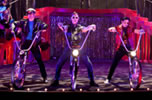 Much Ado About Nothing, Synetic Theater, Arlington, Va. The question going into this production was how well would the "Silent Shakespeare" treatment work on a play in which words are a thematic arc while conversation and "noting" are the lone plot engines. The question leaving the theater was, how could I doubt Synetic? Director Paata Tsikurishvili uses clever mime sequences as well as dancing to make up for the lost words—keeping the original's comedy quotient intact—and creates a setting (a biker gang in 1950s Las Vegas) and key tweaks to the Hero-Claudio marriage plot to make the story fresh and engaging. With a fleet of on-stage motorcycles (just handlebars with headlights), tremendous acting turns by Emily Whitworth as Hero and Scott Brown as Claudio, wondrous acrobatic dancing by Dallas Tolentino as Don John, and a solid core in the two leads of Ben Cunis as Benedick and Irina Tsikurishvili as Beatrice, this, the most challenging of the "Silent Shakespeares," just might be the best.
Much Ado About Nothing, Synetic Theater, Arlington, Va. The question going into this production was how well would the "Silent Shakespeare" treatment work on a play in which words are a thematic arc while conversation and "noting" are the lone plot engines. The question leaving the theater was, how could I doubt Synetic? Director Paata Tsikurishvili uses clever mime sequences as well as dancing to make up for the lost words—keeping the original's comedy quotient intact—and creates a setting (a biker gang in 1950s Las Vegas) and key tweaks to the Hero-Claudio marriage plot to make the story fresh and engaging. With a fleet of on-stage motorcycles (just handlebars with headlights), tremendous acting turns by Emily Whitworth as Hero and Scott Brown as Claudio, wondrous acrobatic dancing by Dallas Tolentino as Don John, and a solid core in the two leads of Ben Cunis as Benedick and Irina Tsikurishvili as Beatrice, this, the most challenging of the "Silent Shakespeares," just might be the best.
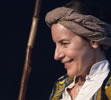 The Tempest, Taffety Punk, Capitol Hill Arts Workshop, Washington, D.C. The Tempest has always been one of my favorite plays, but I never knew it was this good. That's due to Lise Bruneau and her brilliant Riot Grrrls cast, who tackle the text with serious respect and emerge from the scrum with a character-driven, laugh-a-line comedy. Simply staged, the real magic is in the performances, especially the ying-yang (er, princess-girl and bully-brother) performance of Tonya Beckman as Ariel and Caliban, respectively; the exquisitely detailed portrayal of Antonio by Esther Williamson; and the revelatory work of Teresa Spencer as both Ferdinand and Sebastian. Isabelle Anderson's Jewish father of a Prospero sets the benevolent tone of this production, which seems so right. This Tempest is real magic: Shakespeare done purely, simply, and expertly.
The Tempest, Taffety Punk, Capitol Hill Arts Workshop, Washington, D.C. The Tempest has always been one of my favorite plays, but I never knew it was this good. That's due to Lise Bruneau and her brilliant Riot Grrrls cast, who tackle the text with serious respect and emerge from the scrum with a character-driven, laugh-a-line comedy. Simply staged, the real magic is in the performances, especially the ying-yang (er, princess-girl and bully-brother) performance of Tonya Beckman as Ariel and Caliban, respectively; the exquisitely detailed portrayal of Antonio by Esther Williamson; and the revelatory work of Teresa Spencer as both Ferdinand and Sebastian. Isabelle Anderson's Jewish father of a Prospero sets the benevolent tone of this production, which seems so right. This Tempest is real magic: Shakespeare done purely, simply, and expertly.
 Pericles, Oregon Shakespeare Festival, Folger Theatre, Washington, D.C. Director Joseph Haj sees Pericles as a homogeneous play: one writer, one singular concept. He takes his cue from the person of Gower, the play's chorus who narrates the adventures of Pericles in archaic verse—or, as his lines suggest, in song—and gives us a music-filled folk tale told in story form. From the tableaux-like set to the thematic costumes to the verse-centric acting, the production looks, feels, and sounds like folklore, and with strong ensemble acting and the company's ear for the humor in the lines, this piece proves to be wonderfully entertaining.
Pericles, Oregon Shakespeare Festival, Folger Theatre, Washington, D.C. Director Joseph Haj sees Pericles as a homogeneous play: one writer, one singular concept. He takes his cue from the person of Gower, the play's chorus who narrates the adventures of Pericles in archaic verse—or, as his lines suggest, in song—and gives us a music-filled folk tale told in story form. From the tableaux-like set to the thematic costumes to the verse-centric acting, the production looks, feels, and sounds like folklore, and with strong ensemble acting and the company's ear for the humor in the lines, this piece proves to be wonderfully entertaining.
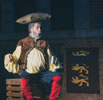 Henry IV, Parts One and Two, Smith Street Stage, Brooklyn, N.Y. The major fault with this production was the environment it played in: an urban park where actors had to vie with the sounds of the city, including an annoying, lingering ice cream truck. Some actors lost the battle, their voices unable to deliver the verse over the ruckus. But those actors who were capable lifted this tandem set of Henry IVs to the heights of good Shakespeare. Director Joby Earle's cuts were (for the most part) justifiable for length, and his rearrangement of scenes served the narration well. But his great achievement was demonstrating the many different relationships in the plays beyond those of Henry IV, Hal, and Falstaff. Michael Hanson was the best Hotspur I've ever seen, son Jonathan Minton was the best Silence I've ever seen (and an explosive Worcester, too), and Jane May made us shudder with Henry's dying speech to Hal.
Henry IV, Parts One and Two, Smith Street Stage, Brooklyn, N.Y. The major fault with this production was the environment it played in: an urban park where actors had to vie with the sounds of the city, including an annoying, lingering ice cream truck. Some actors lost the battle, their voices unable to deliver the verse over the ruckus. But those actors who were capable lifted this tandem set of Henry IVs to the heights of good Shakespeare. Director Joby Earle's cuts were (for the most part) justifiable for length, and his rearrangement of scenes served the narration well. But his great achievement was demonstrating the many different relationships in the plays beyond those of Henry IV, Hal, and Falstaff. Michael Hanson was the best Hotspur I've ever seen, son Jonathan Minton was the best Silence I've ever seen (and an explosive Worcester, too), and Jane May made us shudder with Henry's dying speech to Hal.
 Love's Labour's Lost, Bard on the Beach, Vancouver, B.C. You could say that this was not great Shakespeare. Great Gershwin, great Berlin, great Fats Waller, yes. On the sole basis of the incredibly tight and talented club band (Holofernes on piano, Dull on bass, Dumain on drums, Costard on trumpet), the curvaceous ladies in lovely Roaring Twenties fashion, the singing and the dancing and the "Italian swain" Don Armato (Andrew McNee), this speakeasy-set, musical version of Love's Labour's Lost is theater worth seeing again and again. But though Director Daryl Cloran gutted much of Shakespeare's text, what remains is well played—and what remains is the play's heart, supplemented by some great musical choices.
Love's Labour's Lost, Bard on the Beach, Vancouver, B.C. You could say that this was not great Shakespeare. Great Gershwin, great Berlin, great Fats Waller, yes. On the sole basis of the incredibly tight and talented club band (Holofernes on piano, Dull on bass, Dumain on drums, Costard on trumpet), the curvaceous ladies in lovely Roaring Twenties fashion, the singing and the dancing and the "Italian swain" Don Armato (Andrew McNee), this speakeasy-set, musical version of Love's Labour's Lost is theater worth seeing again and again. But though Director Daryl Cloran gutted much of Shakespeare's text, what remains is well played—and what remains is the play's heart, supplemented by some great musical choices.
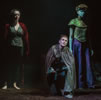 DruidShakespeare: The History Plays, Druid Theatre Company, Lincoln Center Festival, New York, N.Y. At times I grit my teeth. How could they chop out this scene or that scene? At times I marvel that such good editing could enhance Shakespeare's intentions. At times I go slack-jaw at a pedestrian performance or two. At times I am enthralled with Marty Rea's Richard II, Rory Nolan's Falstaff, Karen McCartney's Boy, and anything and everything Aaron Monaghan does (especially Pistol, but also Mowbray, Worcester, Exton, Dauphin, and Chorus). But in the end it is the end—John Olohan's Mistress Quickley staring blankly into the audience—that makes this seven-hour, four-part undertaking such a success. The Druids know their Shakespeare and know their purpose, and adapter Mark O'Rowe and director Garry Hynes manage to meld all four plays into a single unit that asks not only what makes a king an effective king but what makes we, the people, the only true royal we.
DruidShakespeare: The History Plays, Druid Theatre Company, Lincoln Center Festival, New York, N.Y. At times I grit my teeth. How could they chop out this scene or that scene? At times I marvel that such good editing could enhance Shakespeare's intentions. At times I go slack-jaw at a pedestrian performance or two. At times I am enthralled with Marty Rea's Richard II, Rory Nolan's Falstaff, Karen McCartney's Boy, and anything and everything Aaron Monaghan does (especially Pistol, but also Mowbray, Worcester, Exton, Dauphin, and Chorus). But in the end it is the end—John Olohan's Mistress Quickley staring blankly into the audience—that makes this seven-hour, four-part undertaking such a success. The Druids know their Shakespeare and know their purpose, and adapter Mark O'Rowe and director Garry Hynes manage to meld all four plays into a single unit that asks not only what makes a king an effective king but what makes we, the people, the only true royal we.
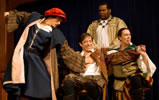 The Merchant of Venice, Baltimore Shakespeare Factory, Baltimore, Md. Our first experience with Original Pronunciation Shakespeare is, in itself, worth a high ranking, and this company mastered OP quite well. You can better appreciate the aural landscape Shakespeare was painting with his verse, and when Valerie Dowdle's Portia moves into her "quality of mercy" speech, the passage unfolds like a hymn. Along with Dowdle, Ian Blackwell Rogers gives us another acting highlight with a Shylock that is a complex blend of villain, victim, hero, and fool. This production lacks both staging and interpersonal dynamics, as if the actors concentrated so hard on mastering OP they didn't fully master their characters and their relationships within the action of the play; yet Portia's speech in OP and a Shylock truly bending to it—but not breaking—are moments I'd relive again and again.
The Merchant of Venice, Baltimore Shakespeare Factory, Baltimore, Md. Our first experience with Original Pronunciation Shakespeare is, in itself, worth a high ranking, and this company mastered OP quite well. You can better appreciate the aural landscape Shakespeare was painting with his verse, and when Valerie Dowdle's Portia moves into her "quality of mercy" speech, the passage unfolds like a hymn. Along with Dowdle, Ian Blackwell Rogers gives us another acting highlight with a Shylock that is a complex blend of villain, victim, hero, and fool. This production lacks both staging and interpersonal dynamics, as if the actors concentrated so hard on mastering OP they didn't fully master their characters and their relationships within the action of the play; yet Portia's speech in OP and a Shylock truly bending to it—but not breaking—are moments I'd relive again and again.
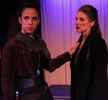 Othello, Titan Theatre Company, Queens Theatre, New York, N.Y.The warriors wore hip-hugging rider pants and jackets, their wives were in elegant, long dresses. It's an Amazonian world, but the fact that all the characters were women (not merely women playing men) brought new perspectives to some of these roles, especially the spoiled airhead brat Roderigo (Leah Gabriel) and the passive aggressive Iago. Laura Frye's portrayal of Iago was rich in nuance, exceptional in delivering the verse, and all-engaging in the way she worked her victims, operating from a deeply self-centered psychosis. I don't think I've ever seen an Iago so scary because I've never seen an Iago so us.
Othello, Titan Theatre Company, Queens Theatre, New York, N.Y.The warriors wore hip-hugging rider pants and jackets, their wives were in elegant, long dresses. It's an Amazonian world, but the fact that all the characters were women (not merely women playing men) brought new perspectives to some of these roles, especially the spoiled airhead brat Roderigo (Leah Gabriel) and the passive aggressive Iago. Laura Frye's portrayal of Iago was rich in nuance, exceptional in delivering the verse, and all-engaging in the way she worked her victims, operating from a deeply self-centered psychosis. I don't think I've ever seen an Iago so scary because I've never seen an Iago so us.
 The Winter's Tale, Pearl Theatre, New York, N.Y. Something mystical happens when the cast enters the dining room set as if at a dinner party in your neighbor's home. They suddenly break off their conversations to look out pleasantly over the audience, then return to their own company. It's not just the shattering of the fourth wall; they have invited us into their company, and it's an easy step from there into the warped perspective of Leontes. Director Michael Sexton's production plays out as delusional imagination on the part of Leontes, portrayed with great intimacy by Peter Francis James, and even the Bohemian scenes take place in Leontes's dining room. Nevertheless, what could have been a deeply navel-gazing presentation turns to great fun in those Bohemian scenes with guitar-playing Adam Green channeling Dylan, Elvis, and Steppenwolf in his portrayal of Autolycus.
The Winter's Tale, Pearl Theatre, New York, N.Y. Something mystical happens when the cast enters the dining room set as if at a dinner party in your neighbor's home. They suddenly break off their conversations to look out pleasantly over the audience, then return to their own company. It's not just the shattering of the fourth wall; they have invited us into their company, and it's an easy step from there into the warped perspective of Leontes. Director Michael Sexton's production plays out as delusional imagination on the part of Leontes, portrayed with great intimacy by Peter Francis James, and even the Bohemian scenes take place in Leontes's dining room. Nevertheless, what could have been a deeply navel-gazing presentation turns to great fun in those Bohemian scenes with guitar-playing Adam Green channeling Dylan, Elvis, and Steppenwolf in his portrayal of Autolycus.
 As You Like It, Baltimore Shakespeare Factory, Baltimore, Md. "The play is a bit like a messy playroom where Shakespeare left his toys out all over the floor. But what a wonderful mess of toys to play with!" Director Chris Cotterman wrote that in the program notes, and it's as insightful as it is descriptive of his production. Maintaining almost religious fealty to the text, this production lets Shakespeare's singularly-peopled play with its lovely language (which this cast generally speaks well) earn its own, many laughs. Yet in Cotterman's energetic hands, As You Like It becomes something of a burlesque show, moving from schtick to schtick, with Touchstone (Phil Vannoorbeeck) topping the bill but sweet Phoebe (Charlotte Blacklock) and lovelorn Sylvius (Tavon McLaughlin) stealing our hearts.
As You Like It, Baltimore Shakespeare Factory, Baltimore, Md. "The play is a bit like a messy playroom where Shakespeare left his toys out all over the floor. But what a wonderful mess of toys to play with!" Director Chris Cotterman wrote that in the program notes, and it's as insightful as it is descriptive of his production. Maintaining almost religious fealty to the text, this production lets Shakespeare's singularly-peopled play with its lovely language (which this cast generally speaks well) earn its own, many laughs. Yet in Cotterman's energetic hands, As You Like It becomes something of a burlesque show, moving from schtick to schtick, with Touchstone (Phil Vannoorbeeck) topping the bill but sweet Phoebe (Charlotte Blacklock) and lovelorn Sylvius (Tavon McLaughlin) stealing our hearts.
 The Winter's Tale, American Shakespeare Center, Blackfriars Playhouse, Staunton, Va. This elegant and elegiac production takes on the women's perspective under the direction of Jenny Bennett, casting the two kings, Leontes (James Keegan) and Polixenes (René Thornton Jr.) as beastly in their sudden fits of anger (the bear has nothing on them). Meanwhile, the production belongs to the women, poignantly played by Abbi Hawk (Hermione), Stephanie Holladay Earl (Perdita), and Sarah Fallon (Paulina). As serious as this play can get, Bennett never wavers from its funny moments, even inserting a bit of Prince and John Denver into the sheep-shearing feast.
The Winter's Tale, American Shakespeare Center, Blackfriars Playhouse, Staunton, Va. This elegant and elegiac production takes on the women's perspective under the direction of Jenny Bennett, casting the two kings, Leontes (James Keegan) and Polixenes (René Thornton Jr.) as beastly in their sudden fits of anger (the bear has nothing on them). Meanwhile, the production belongs to the women, poignantly played by Abbi Hawk (Hermione), Stephanie Holladay Earl (Perdita), and Sarah Fallon (Paulina). As serious as this play can get, Bennett never wavers from its funny moments, even inserting a bit of Prince and John Denver into the sheep-shearing feast.
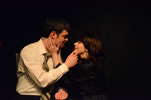 Arden of Faversham, Brave Spirits, Atlas Performing Arts Center, Washington, D.C. Does this play even belong on this list? Scholars and textual studies suspect Shakespeare's along with Christopher Marlowe's and Thomas Kyd's compositional hands in the 1592 non-credited script. As a piece of theater, and as presented by Brave Spirits, it is in itself worthy of a high rank on either the Shakespeare or non-Shakespeare list, but I'm ranking this play based on its Shakespearean cred: the proto-feminist character of Alice Arden, played with seductive guile by Victoria Reinsel; the respectful-but-yet-white-trash portrayals of Black Will and Shakebag; the wit driven by personalities and a clever script; and, most of all, the beautifully constructed verse that occasionally emerges in the middle of the action. If Shakespeare didn't write any of this, he probably wished he had.
Arden of Faversham, Brave Spirits, Atlas Performing Arts Center, Washington, D.C. Does this play even belong on this list? Scholars and textual studies suspect Shakespeare's along with Christopher Marlowe's and Thomas Kyd's compositional hands in the 1592 non-credited script. As a piece of theater, and as presented by Brave Spirits, it is in itself worthy of a high rank on either the Shakespeare or non-Shakespeare list, but I'm ranking this play based on its Shakespearean cred: the proto-feminist character of Alice Arden, played with seductive guile by Victoria Reinsel; the respectful-but-yet-white-trash portrayals of Black Will and Shakebag; the wit driven by personalities and a clever script; and, most of all, the beautifully constructed verse that occasionally emerges in the middle of the action. If Shakespeare didn't write any of this, he probably wished he had.
Honorable Mentions:
Top 10 Non-Shakespearean Theatrical Moments of 2015
- Our Town, Faction of Fools, Washington, D.C. (see Best Show of Shows above)
- Something Rotten, St. James Theatre, New York, N.Y. Rules are rules: Only if a play is (probably and mostly) by William Shakespeare does it qualify as a "Shakespeareance" in these rankings. If the play features Shakespeare, it's still relegated to the non-Shakespeare Honorable Mention list. But this Shakespeare is the best Shakespeare I've seen all year, Christian Borle's portrayal of the pop star Bard that won him a Tony. On the whole, Something Rotten—a musical sending up musicals—is ingenious fun and would have landed in the Top Five in and of itself; but Borle achieves something I've only experienced one other time in all the theater I've seen: a performance that is more than indelible—it possesses you. In 1985 I saw the Howard Brenton and David Hare play Pravda, and to this day I will sometimes slip into the stance and vocal characteristics of Lambert Le Roux as played by Anthony Hopkins. These days I'm mimmicking the mannerisms and speaking the catch-phrases of Borle's Shakespeare, even whining in my late nights of writing and editing about how "It's so hard to be The Bard."
 Dunsinane, National Theatre of Scotland, Royal Shakespeare Company, Shakespeare Theatre Company, Sidney Harman Hall, Washington, D.C. The first hint that you are in for a brilliant night of theater comes in the first speech by the Boy Soldier (Tom Gill) describing his and his fellow English soldiers heading to Scotland to "install a king." "All of us knowing and not knowing what lay ahead of us." Thus it was vwith us, the audience: knowing that we were seeing David Greig's sequel to William Shakespeare's Macbeth, not knowing we were getting a lesson in the futility of nation-building wars. Post-Macbeth Scotland as a metaphor for modern Iraq and Afghanistan gives Dunsinane its intellectual depth, but Greig has also given us a great yarn superbly directed by Roxana Silbert and played by a stellar company of actors on the production's North American tour.
Dunsinane, National Theatre of Scotland, Royal Shakespeare Company, Shakespeare Theatre Company, Sidney Harman Hall, Washington, D.C. The first hint that you are in for a brilliant night of theater comes in the first speech by the Boy Soldier (Tom Gill) describing his and his fellow English soldiers heading to Scotland to "install a king." "All of us knowing and not knowing what lay ahead of us." Thus it was vwith us, the audience: knowing that we were seeing David Greig's sequel to William Shakespeare's Macbeth, not knowing we were getting a lesson in the futility of nation-building wars. Post-Macbeth Scotland as a metaphor for modern Iraq and Afghanistan gives Dunsinane its intellectual depth, but Greig has also given us a great yarn superbly directed by Roxana Silbert and played by a stellar company of actors on the production's North American tour.
- The Curious Incident of the Dog in the Night-Time, the National Theatre, Ethel Barrymore Theatre, New York, N.Y. I went into this play with high expectations—but not knowing exactly what to expect—since its original staging at London's National Theatre created instant buzz. Upon seeing it all I could say was Whoa! The story of a teen-ager with autism trying to solve the mystery of a dead dog and running away from his provincial home to the metropolis of London is powerful, profound, and incredibly acted by a strong ensemble around Tyler Lea as Christopher. [Review coming.]
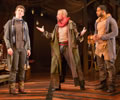
- Rosencrantz and Guildenstern Are Dead, Folger Theatre, Washington, D.C. The Player in Tom Stoppard's Hamlet spin-off is a part for a gifted actor to sink his teeth into, and Ian Merrill Peakes approaches the part with a great appetite. From his pre-show announcements to his final exit, Peakes's Player is always on, one of the great individual performances we've seen this year. Director Aaron Posner takes a playful approach to the play and a youthful one, too, casting young but gifted talent as Guildenstern (Adam Wesley Brown) and Rosencrantz (Romell Witherspoon).

- The Metromaniacs, Shakespeare Theatre Company, Lansburgh Theatre, Washington, D.C. After his adaption of the French classic, The Liar, created one of our favorite nights of theater ever, and his second adaptation, of The Heir Apparent, was almost as good, David Ives' latest adaptation, The Metromaniacs gives him a triple crown in his collaboration with director Michael Kahn. In a period piece featuring multiple layers of characters going incognito, Ives has perfected his skills at creating rhyming couplets that sound like prose-like dialogue, and a sharp cast makes it all seem so illogically logically perfect.

- The Rover, American Shakespeare Center, Blackfriars Playhouse, Staunton, Va. Apha Behn has created one of the greatest scoundrels in all of theater with the character of Willmore, and all John Harrell has to do is wink his way through the play to be a hit. But he brings such sincerity to the person and wraps gullibility into bravado that we end up loving him, too. We also love Lauren Ballard as Hellena, the young lady who matches wits and wins the heart of Willmore against his nature.
- Grounded, Public Theater, New York, N.Y. Our second experience in six weeks of this one-woman play about an Air Force
 fighter pilot flying drones and suffering from post-traumatic stress disorder earns this Top Ten ranking thanks to a revamped version of George Brent's script, Julie Taymor's brilliant direction, and Anne Hathaway as the Pilot. On a sand stage serving as a screen for projections of the Pilot's various environments, Hathaway gives an in-her-skin portrayal of the Pilot in a genuine and powerful performance.
fighter pilot flying drones and suffering from post-traumatic stress disorder earns this Top Ten ranking thanks to a revamped version of George Brent's script, Julie Taymor's brilliant direction, and Anne Hathaway as the Pilot. On a sand stage serving as a screen for projections of the Pilot's various environments, Hathaway gives an in-her-skin portrayal of the Pilot in a genuine and powerful performance.
- A Christmas Carol, Blackfriars Playhouse, Staunton, Va. Allison Glenzer gets to the very heart of Scrooge as Charles Dickens details him, from his miserly misery in the opening scenes through his eventful path to redemption.
 Meanwhile, the cast, through similar truthful portrayals and tremendous musical talent and abetted by the Blackfriars Playhouse environment with the audience being physically as well as emotionally drawn into the action, gives the production real Christmas spirit past, present, and future.
Meanwhile, the cast, through similar truthful portrayals and tremendous musical talent and abetted by the Blackfriars Playhouse environment with the audience being physically as well as emotionally drawn into the action, gives the production real Christmas spirit past, present, and future.
- Wolf Hall, Parts One & Two, Royal Shakespeare Company, Winter Garden, New York, N.Y. The RSC's adaptation of Hilary Mantel's historical novel into two parts, "Wolf Hall" and "Bring Up the Bodies" creates an edgy political thriller out of what looks on first blush to be a luscious costume drama. Ben Miles navigates a minefield of conspiracies and emotional conundrums as Cromwell, while Nathaniel Parker wonderfully captures the genius and disingenuous ways of Henry VIII.
The rest of the Shakespeareances …
- Henry IV, Donmar Warehouse, St. Ann's Warehouse, Brooklyn, N.Y. Strong acting and insightful interpretations of roles lift this production from a disappointment that comes with too-high expectations. After Donmar's mind-blowing women's prison production of Julius Caesar in 2013, we figured to get another such experience with the even greater play of Henry IV. But this time the women's prison setting comes off as more gimmick than revealing. Still, we do get Harriet Walter as a deeply meditative Henry walking the fine line of motherhood and political rule, and Clare Dunne's Hal, who shows us that the Prince of Wales is, indeed, a criminal. [Review coming.]
- Julius Caesar, American Shakespeare Center, Blackfriars Playhouse, Staunton, Va. The ASC has gathered another fine collection of acting and musical talent for its touring troupe, but the key to this production's success is in the director, erstwhile Blackfriars Playhouse regular Benjamin Curns. As an actor, Curns peered into the depths of every line he spoke, and he applies that laser focus of Shakespeare's script to this production, bringing to the fore personality traits, cultural clues, and more humor than you thought existed in this speech-heavy play. Dressed in Elizabethan costumes, this Julius Caesar perhaps reveals much of the genius behind the composing pen. [Review coming.]
- The Merchant of Venice, Atlanta Shakespeare Company's Shakespeare Tavern, Atlanta, Ga. Just the fun and friendly environment of the Shakespeare Tavern adds points to any production we see there. Meanwhile, the product on stage is usually hit and miss, and this version of Merchant is no exception. At least the ratio was 4:1—nice performances by Sam R. Ross as Antonio, Doug Kaye as Shylock, Matt Nitchie as the Duke, Morocco, Old Gobbo, and Tubal, and Matt Felten as Launcelot and Arragon balanced against a most irritating Bassanio and his infatuation with his hair. Yet, it was Director Laura Cole's keen interpretations that stand out in this production: Solanio's and Salerino's mocking ways toward Antonio and Bassanio as well as Shylock, Jessica's greediness, Lorenzo as kindred spirit to Gratiano, and Portia's impulsiveness.
- Henry V, American Shakespeare Center, Blackfriars Playhouse, Staunton, Va. Using a mish-mash of costumes combining Elizabethan dress with modern accessories, and adding a number of visual pop references (the priests' poster-board briefing on Salic Law made the whole speech entertaining) give this production a fun edge. But its core of characters don't resonate, except Josh Innerst as Chorus, who comes on the stage, meditates hard, and then bursts with his opening line imploring us to imagine what he can't even begin to adequately portray with his words. [Review coming.]
- As You Like It, Synetic Theater, Arlington, Va.Director Paata Tsikurishvili always takes some liberties with Shakespeare's plots to achieve his "Silent Shakespeare" productions, but he generally makes up for that with keen character studies and visual imagery. With a modern urban-set As You Like It, he departs more from Shakespeare's characters than the play's plot—Touchstone as a body guard?—but he takes full advantage of the talents his actors bring to the show, from a tap-dancing Audrey and a pole-dancing Phebe to a guitar-slinging Touchstone and keyboard-playing (and soundtrack composer) Konstantine Lorkipanidze as Amiens. In the middle of it all is Scott Brown, unrecognizable as Jaques who, using masks and mime, takes us through the Seven Ages of Man.
- The Taming of the Shrew, American Shakespeare Center, Blackfriars Playhouse, Staunton, Va. On the one hand, when The Taming of the Shrew is produced using the Actors' Renaissance Season methodology—no director, no design team, actors getting only a few days to work out and rehearse the play before public performance—we see the glaring inconsistencies in what may have been the young Shakespeare's first play. However, we also get the contributions of the individual 12 actors, and while they costume themselves in a hodge-podge of styles and extremities, they present a tight, audience-appealing play. In particular you get Allison Glenzer's intelligent portrayal of Katherina and her journey from hating the world to loving Petruchio, played by Christopher Seiler. Extra kudos to Michael Amendola for his brilliant take on the Widow and his three-times-a-laugh joke with the prompter.
- The Tempest, Aquila Theatre, George Mason University's Center for the Arts, Fairfax, Va. This six-actor touring production of The Tempest, directed and adapted by Desiree Sanchez, diminishes some of Shakespeare's stage genius through cuts. However, it enhances the Bard's philosophical musings through its choices and setting, which seems to be an artist's studio with Ariel as Prospero's muse. Never have I heard the "We are such stuff as dreams are made on" speech delivered with such deep meaning as I did in this production. Unfortunately, that is about all I heard in this production, with bad acoustics and diction among some members of the cast making much of the dialogue incomprehensible.
- Hamlet: The First Quarto, Taffety Punk, Capitol Hill Arts Workshop, Washington, D.C. If we rank according to academic experience and theatrical adventure, this one would land near the top. Rare do you get a chance to see staged the First Quarto version of Hamlet , and Taffety Punk enhances the script with some insightful interpretations of Hamlet himself and some stellar performances from Daniel Flint as the king, Jessica Lefkow as Gertred, and Jim Jorgensen as Corambis (aka Polonius) and the Gravedigger. Marcus Kyd does a good Hamlet when he's moving the plot along, but a merely serviceable Hamlet when he's contemplating the great questions of life. That's because the script is, in a word, awful. There's a reason it's generally known as "the Bad Quarto." It's great that we got to experience it once; but experiencing it again would be a grate thing.
- Romeo and Juliet: Love Knows No Age, Unexpected Stage Company, Wheaton, Md.The premise is promising, but in practice, the idea of Romeo and Juliet being set in a retirement community doesn't hold up to the plot and circumstances Shakespeare handed us. Regrettably, too, many of the cast, new to Shakespeare, don't have the requisite verse-reading skills to make their characters engaging. The important exceptions are Romeo (Elliott Bales) and Juliet (Claire Schoonover) who are one of the sexiest presentations of the famous "young lovers" I've ever seen. Kudos to director Christopher Goodrich for not only illustrating the agelessness of all-consuming love, but touching on issues of elder abuse, too.
- The Taming of the Shrew, Baltimore Shakespeare Festival, Baltimore, Md.Near-disaster struck this production earlier in the day when a car accident kept the actress playing Biondello from going on stage. Director Thomas Delise filled in by having other actors, on book, speak Biondello's lines. Katie Arlyan got the lion's share of extra lines while also playing Grumio, Vincentio, and other minor roles. Her performances of each of these characters are richly drawn, and she also takes ownership of Biondello, delivering her lines with subtle inflections even while reading them off a piece of paper. She's ready for Hamlet.
- Shakespeare's Joan of Arc (Henry VI, Part One), American Shakespeare Center, Blackfriars Playhouse, Staunton, Va. This production, featuring brilliant performances from its two title characters, Abbi Hawk as Joan and Stephanie Holladay Earl as Henry, suffers one major drawback: it's not its Blackfriars Playhouse forebearer, the 2009 Actors' Renaissance Season production of the play. That one, using Shakespeare's original production practices, was chaotic fun and easy melodrama. This more studied version not only lacks that go-for-it spark, it has a listless time maintaining its multi-character storyline.
- Henry IV, Parts One and Two, Brave Spirits Theatre, The Lab at Convergence, Alexandria, Va. What's not to like: Henry IV, Part One and Part Two in repertory, Brave Spirits, and regendering of the roles. What's not to like, it turns out, are the productions themselves, excessively cluttered with stage busyness, music, and hyper-acting. Lost in all the clutter (and the cuts required to fit in a total of the 30 musical interludes) are the text and any insights that would be generated by regendering the roles. The result is nothing more than a guilty pleasure of watching a Gang Girl movie, with women being nasty, getting drunk, and fighting.
- King Lear, Bard on the Beach, Vancouver, B.C. We traveled all the way to Vancouver to see this play and Shakespeare's Rebel. Thank goodness we did: for otherwise we would have missed the company's productions of The Comedy of Errors and Love's Labour's Lost. Benedict Campbell's title character—with an interpretation of "mad" as "angry" rather than insane or senile—gives this production no emotional anchor to which we could attach our empathy. An opening scene that stresses a blissful family dynamic instead of undertows of family dissonance—thereby altering the source of the chaos to come—is a thematic misstep from which the cast never gains a solid footing with their characters. Aside from a particularly gross eye-gouging scene, there's really not much else to see here.
- Cry, Trojans!, The Wooster Group, St. Ann's Warehouse, Brooklyn, N.Y. I snatched at the opportunity to see this production, knowing its heritage as one half of a partnership with the Royal Shakespeare Company during the World Shakespeare Festival. I left the theater beyond disappointed and bothered at both the manner of the production—an aren't-we-cool-and-clever aesthete intended to establish a superior attitude over the audience—and the Hollywood stereotypes it uses in its portrayal of the Trojans as Native Americans. This is an intentional attempt to hold a mirror up to our racial prejudices, but that mirror is actually a window looking into the white faces purporting to speak for Native Americans.
…and the rest of the non-Shakespeareances:
- No Spring Chicken, NextStop Theatre Company, Herndon, Va. Playwright and actress Ginna Hoben tackles the topic of "advanced-age pregnancy"—her own—in this one woman show. It was her performance that rocked me at the time of watching the show, but in piecing together the thematic strands of the play afterward I realized why its surprising ending had such a profound impact on me. This is a play about aging, pregnancy, relationships, the health-care system, and health-care providers, but at its core it is a play about the essence of life.
- West Side Story, Signature Theater, Arlington, Va. Except for the tease of listening to the original movie soundtrack, I came into this production a West Side Story virgin. From the first finger-snapping entrance of the Jets and Sharks I realized why this musical is exalted way beyond its Shakespearean origins. Director Matthew Gardiner expertly uses Signature's deep-thrust stage in every scene, from the street rumbles to the dream sequences, and Parker Esse bases his choreography on Jerome Robbins' original, a stunning combination of ballet with jazz. But it's the music—Leonard Bernstein's score and Stephen Sondheim's lyrics ably performed by orchestra and cast under Jon Kalbfleisch's direction—that creates the awe.
- Man of La Mancha, Shakespeare Theatre Company, Sidney Harman Hall, Washington, D.C. I had no great desire to see this, simply because I prefer theaters I subscribe to with Shakespeare in their name to give me more Shakespeare and less modern pabulum. No pabulum in this Alan Paul-directed production. A great ensemble cast acts, sings, and dances their way through a spirited but intelligent production, with Anthony Warlow in the lead—never letting go of his character even as his beautiful voice smoothly climbs the register for "Impossible Dream"—and Amber Iman as a sassy but soulful Aldonza.
- texts&beheadings/ElizabethR, Folger Theatre, Washington, D.C. With a script using England's Queen Elizabeth I's own writings, this Compagnia de'Colombari play is set into four movements: one focusing on her refusal to marry, one on her survival (political and personal), one on her religious faith, and one on her sovereignty. Each actress takes the lead in one movement while the others serve as a chorus. Theme-based, the narrative hop-scotches around, making it confusing to follow. But the four queens, Monique Barbee, Ayeje Feamster, Juliana Francis-Kelly, and Cristina Spina, give arresting performances, while Elizabeth herself emerges as an engaging personality.
- The Twelve Dates of Christmas, Blackfriars Playhouse, Staunton, Va. Stephanie Holladay Earl takes on the part of Mary in Ginna Hoben's somewhat autobiographical tale of looking for romance over the course of one year's worth of holidays. With superb backing from Doo Wop Girls Susie Parr and Zoe Speas, Holladay Earl brings much greater psychological nuance and emotional heft to the part of Mary, and by doing so enriches an already rich script.
- Tartuffe, Shakespeare Theatre Company, Sidney Harman Hall, Washington, D.C. Disconcerting comedy. We laugh at a running joke while we cringe at what we see. We hang onto every line of the rhyming script and are hung up on the long pauses between lines. We find much humor in Molière's presentation of religious hypocrisy, and we feel much disturbed by its topical relevance. The incisive direction of Dominique Serrand brings this play to life, hypnotizing us with its precise choreography and impeccable acting, especially the seduction scenes between Tartuffe (Steven Epp) and Elmire (Sofia Jean Gomez).
- The Importance of Being Earnest, American Shakespeare Center, Blackfriars Playhouse, Staunton, Va. This play is almost impossible to ruin, but it can also rise above the norm, and under Kevin Rich's direction, this touring troupe production does so. Take a talented cast and inject more romantic energy into the proceedings than I've seen in previous productions, and you get high-brow hijinks in just the right doses. Josh Innerst displays his comic capabilities as Algernon, and Andrew Goldwasser provides a straight (and therefore funny) reading of Lady Bracknell. [Review coming.]
- A Tale of Two Cities, Synetic Theater, Arlington, Va. It was the best of times: Vato Tsikurishvili as the Baby, a big and most expressive clown of an actor's head on a puppet baby's body. It was the most average of times: the accomplished Alex Mills as the drag queen Jerry performing the myriad of characters in Charles Dickens A Tale of Two Cities in order to calm the baby to sleep. Mills has incredible dancing talent, but his more traditional acting skills needs honing before tackling such a task, and thus did the Dickensian portions drag. However, under Director Serge Seiden's guidance, the addition of an actual actor as the baby, the interaction of Jerry with Baby, and Mills' striptease dance as he prepared for his bath are highlights of this theater year.
- Mary Stuart, Folger Theatre, Washington, D.C. Hard call. An exemplary cast was constructed for this production, led by Kate Eastwood Norris as Mary and Holly Twyford as Elizabeth (that casting alone made this the early great anticipation for 2015). Director Richard Clifford's staging was rather static, but the two queens and the rest were superb in playing their characters (special kudos to Rajesh Bose's bully but loyal Lord Burleigh and Louis Butelli's loyal but stalwartly ethical Sir Amias Paulet). Yet, ironically, that revealed the play's warts, from its clumsy expository dialogue to its moral shift toward a self-absorbed Mary as the play's martyred hero. This may have been some of the best acting I've seen in a long while, but it left me disappointed in the characters themselves.
- The White Devil, American Shakespeare Center, Blackfriars Playhouse, Staunton, Va. Typical of John Webster, this play has a convoluted plot full of morally bankrupt people doing really horrendous stuff. It also has some wonderful lines, and the characters themselves are as multidimensional as anything Shakespeare wrote. But the real attraction here is the stellar acting of the Actors' Renaissance Season troupe that gives each and every line emotional depth, with Chris Johnston getting his leading man moment as the caged songbird villain Flamineo.
- Grounded, Olney Theatre Center, Olney, Md. Sometimes, you know too much to be a satisfied audience. George Brant has written an enthralling one-woman show about a fighter pilot assigned to fly drones and suffering PTSD as a consequence. He takes on the ethical issues of drone warfare, and in both his portrayal of the Pilot and Megan Anderson's all-in performance in the role, there is much truth, from her fighter-jock God complex to her devoted husband named Eric. Yet, Brant exaggerates with pilot stereotypes, turns the commander into an unlikely antagonist, and has too many holes of legitimacy in his depiction of an Air Force career, undermining the play's main themes and purpose.
- Every Man in his Humour, American Shakespeare Center, Blackfriars Playhouse, Staunton, Va. Any cast starts this play in a huge hole: Ben Jonson created some great characters, but he wasn't creative with his plots, which in this play amounts to cool people playing pranks on fools. Thus we get the necessity of spending half the play establishing characters in order to sell the audience on the humor of the stupid pranks. The Actors' Renaissance Season troupe gets us through that exposition phase to an enjoyable payoff, in particular Patrick Midgley as Captain Bobadill, one of the great braggart cowards in all of English drama.
- Salomé, Shakespeare Theatre Company, Lansburgh Theatre, Washington, D.C. Director Yaël Farber has adapted the story of Herod's stepdaughter dancing the dance of the seven veils and having John the Baptist (Iokanaan) beheaded into a feminist tale of a woman victimized by the misogynist society of Roman-occupied Judea and martyring Iokanaan to spark rebellion. So, this is not Oscar Wilde's play (a few of his lines do make it into this adaptation). It's a play meant to challenge rather than entertain, but it also yields visually arresting staging, with Movement Director Ami Shulman getting the cast to use motion and posture to reveal their characters as much (if not more) than the lines they speak.
- Mother Bombie, American Shakespeare Center, Blackfriars Playhouse, Staunton, Va. Some works of art seem better left for the obscurity bin of history. John Lyly's Mother Bombie is one of those. It would be included in the Shakespeare Colleague Box Set of plays only on the basis of Lyly being an influencer of early Shakespeare (plus one line about a joint stool that would be repeated 15 years later in King Lear). Of course, the curators of this box set is the ASC, specifically its Actors' Renaissance Season troupe, and these actors manage to use their verse-reading skills and interpretative geniuses to stage an entertaining play, especially the trio of love scenes: Bridget Rue's Livia and Nathan C. Crocker's Candius getting orgasmic over her stitchery and his Latin lessons; Sara Hymes's Serena and Benjamin Reed's Maestius trying to tamp down their incestuous lust in a hilariously choreographed conversation that heightens their passion; and Lauren Ballard as stupid Silena and Michael Amendola as stupid Accius meeting for the first time.
- Kiss Me Kate, Shakespeare Theatre Company, Sidney Harmon Hall, Washington, D.C. Even with its famous songs, this Cole Porter-composed musical is a trifling affair, so give much credit to Director Alan Paul and Choreographer Michele Lynch for seamlessly weaving wonderful full-cast dance sequences in and out of the plot. Robyn Hurder wows with her pipes and her dancing skills as Lois Lane, and Bob Ari and Raymond Jaramillo McLeod as the unnamed hoodlums are hoot; let them take as many encores as they want for their soft-shoe presentation of "Brush Up Your Shakespeare."
- The Originalist, Arena Stage, Washington, D.C. For me, this play has a huge obstacle blocking my enjoyment: the lead character, Supreme Court Justice Antonin Scalia. Fortunately, playwright John Strand and actor Edward Gero bring out the charm and humor in the man along with his brilliant mind and infuriating extremist politics. In fact, it's the portrayal of the overly earnest liberal law clerk, Cat, and the let's-make-everybody-happy ending that ultimately sinks this play.
- Vanya and Sonia and Masha and Spike, Arena Stage, Washington, D.C. Even if you are not expert on Chekhov—and I am not—along with the obvious Chekhovian references you can appreciate playwright Christopher Durang's biting wit and portrait of social morass that serves as a Chekhovian subtext of his play. Aaron Posner put together an accomplished cast, though at times the chemistry never seems to click. His chief get was the brilliant Eric Hissom as Vanya. Watching Hissom's character carefully navigate the frazzled family dynamics and his own sexual identity is the kind of performance that merits your constant attention, and his long monologue of unleashed frustration near the play's end receives a deserved ovation from the audience.
- The Iceman Cometh, Goodman Theatre, BAM Harvey Theater, Brooklyn, N.Y. Goodman Artistic Director Robert Falls has put together a tremendous production, from the grimy, you-are-there set to the incredible ensemble performances, led by Brian Dennehy as Larry Slade and Nathan Lane as Hickey. It's what a Eugene O'Neill classic deserves. It also deserves an editor. At 4:45 including three intermissions, this sucker is too long with all its redundant profundities hammering us over and over and over and over…
- Shakespeare's Rebel, Bard on the Beach, Vancouver, B.C. C.C. Humphreys jams five plots and so many conspiracies and counter-conspiracies into his new play that we get as exasperated at all the goings on as does his one-dimensional protagonist, John Lawley (Benedict Campbell). Meanwhile, the preponderance of Shakespeare references (and the sulking Shakespeare himself) are more irritating than clever.
- Laugh, Studio Theatre, Washington, D.C. Beth Henley's new play is intended to both capture the nervy energy of the silent movie era and use the silent movie as a metaphor of life, but other than narrator Wayne Barker's jaunty live piano soundtrack, the production never gels. Instead of laughing, many in the audience end up leaving.
Comment: e-mail editorial@shakespeareances.com
Start a discussion in the Bardroom





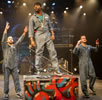
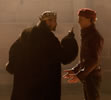


 Find additional Shakespeareances
Find additional Shakespeareances